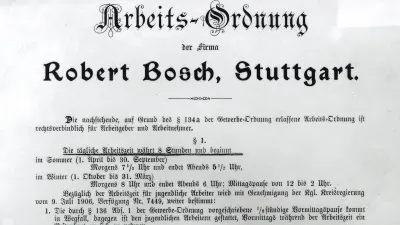Stuttgart premiere – Robert Bosch introduces the eight-hour day in 1906

Robert Bosch marked the manufacture of the 100,000th magneto ignition system by introducing the eight-hour working day on June 23, 1906.
One step ahead of the times

Robert Bosch marked the manufacture of the 100,000th magneto ignition system by introducing the eight-hour working day on June 23, 1906. At no other industrial company in the city were workers allowed to down tools so soon. Robert Bosch was one of the first industrialists in Germany to initiate a shorter working day. The new work rules stipulated that associates had to work from 8 a.m. to 6 p.m., with a two-hour lunch break. Because Saturday was still a normal working day at the time, this was equivalent to a 48-hour week. A glimpse at the typical working hours in the Stuttgart iron and metalworking industry shows just how unusual this was at the time. Staff worked between 57 and 60 hours a week at more than half of companies and even longer at a good third of businesses.
“I introduced the eight-hour day very early on […] because I believed it the most efficient solution economically, as well as the best way of preserving human capacity for work.”
Social and business considerations
Alongside social factors, it was above all business considerations that influenced Robert Bosch’s decision to introduce the eight-hour working day. The Bosch magneto ignition was a huge success worldwide. In 1904 and 1905, Bosch was barely able to keep pace with demand, even though the number of associates was rising and the factory complex in the west of Stuttgart was constantly being extended. It was for this reason that Robert Bosch opted for a reorganization of working hours, with production now being divided into two eight-hour shifts.
He was sufficiently encouraged by the positive results of this experiment to move toward a permanent eight-hour day. Contrary to general expectation, there was no reduction in the quantity of goods produced per shift, even though working time had been cut by one hour. Indeed, productivity actually increased slightly.
The eight-hour working day wasn’t the only special feature Robert Bosch had to offer as an employer.

Author: Dietrich Kuhlgatz
